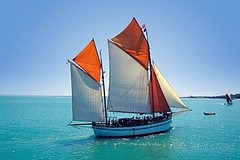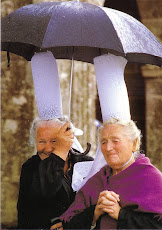 Image by Haute Bretagne via Flickr
Image by Haute Bretagne via FlickrLE CONQUET, the southernmost of the abers resorts, at the far western tip Brittany 24km beyond Brest, makes the best holiday base of all. A wonderful place - scarcely developed, it is flanked by a long beach of clean white sand, protected from the winds by the narrow spit of the Kermorvan peninsula, and has ferry access to the islands of Ouessant and Molene. It is very much a working fishing village, the grey-stone houses leading down to the stone jetties of a cramped harbour — which occasionally floods, to the intense amusement of the locals. the waves washing over the cars left by tourists making the trip to Ouessant.
The coast around Le Conquet is low-lying, not the rocky confrontation with a savage sea that one might expect, and Kermorvan, across the estuary, seems to glide into the sea — its shallow cliffs are topped by a strip of turf that looks as if you could peel it right off. Apart from the lighthouse at the end, the peninsula is just grassland bare of buildings and a lovely place to walk in the evening across the footbridge from Le Conquet.
The most exciting trips out from Le Conquet are to the islands — detailed in the box opposite. As a variation, though, a good walk 5km south brings you to the lighthouse at Pointe St-Mathieu, looking out to the islands from its site among the ruins of the Benedictine Abbaye de St-Mathieu. A small exhibition (April & May Wed, Sat & Sun 2.30—6.30pm; June & Sept daily 2.30—6.30pm; July & Aug daily 11 am—7pm; Oct & Nov Wed, Sat & Sun 2—6pm; IOF/€1.52) explains the abbey’s history, including the legend that it holds the skull of St Matthew brought here from Ethiopia by local seafarers.
Practicalities
The Relais du Vieux Port, quai Drellac (02.98.89.15.91;closed Jan), offers a handful of inexpensive but attractive rooms right by the jetty in Le Conquet, and has a simple creperie downstairs. Nearby, the larger Pointe Ste Barbe (02.98.89.00.26)—CD; closed Mon out of season & mid-Nov to mid-Dec) offers amazing sea views to guests in its more expensive rooms, and has a great restaurant, where menus start at 100F/€15.24. There are also two well-equipped two-star campsites, Le Theven (02.98.89.06.90; closed Oct—March) and Quere (02.98.89.11.71; closed mid-Sept to mid June). Market day in Le Conquet is Tuesday.
The Hostellerie de la Pointe St-Mathieu, housed in a thirteenth-century stone structure opposite the abbey entrance at Pointe St-Mathieu ($02.98.89.00.19; (O; closed Sun evening in low season), is a top-quality restaurant that has added a modern wing of tasteful ocean-view rooms.
The islands of Ouessant and Molene
The island of Ouessant, Ushant in English — and first described by the geographer Pytheas as early as 325 BC, under the name of Uxisama — lies 30km northwest of Le Conquet. Standing at the outermost end of a chain of smaller islands and half-submerged granite rocks its lighthouse at Creac’h (said to be the strongest in the world) is regarded as the entrance to the English Channel. Most of the archipel¬ago is uninhabited, save perhaps, like Beniguet, for a few rabbits, but Molene, midway, has a village and can be visited. Both Molene and Ouessant are served by at least one ferry each day from Le Conquet and Brest; however, it is not practicable to visit more than one in a single day. Note that the ferries can be very crowded in summer, and it’s well worth booking your tickets in advance if at all possible.
Getting to Ouessant and Molene
Penn Ar Bed (02.98.80.80.80, www.penn-ar-bed.fr) sail to Ouessant and Molene all year, with up to five daily departures from Le Conquet (first sailing at 8am daily in summer; return fare adult 157F/€23.94, under-17s 94F/€14.33), and one daily at 8.30am from Brest (return fare adult 186F/€28.35, under-17s 112F/€17.07). They also depart from Camaret at 8.45am on Wednesday from May until mid-July, and Monday to Saturday at 8.45am from mid-July until the end of August (return fare adult 17OF/€25.92, under-17s 100F/€15.24).
Finist’Mer operate high-speed ferries to Ouessant in summer only, from Camaret (02.98.27.88.44; return fare adult 160F/€24.39, under-17s 95F/€14.48), Le Conquet (x02.98.89.16.61; adult 148F/€22.56, under-17s 84F/€12.81) and Lanildut, 25km northwest of Brest (x02.98.04.40.72; adult 155F/€23.63, under-17s 90F/€13.72). Bikes cost 65–70F/€9.91–10.67 extra. In June and September, they offer a daily departure from Camaret at 8.30am, calling at Le Conquet at 9.30am, another departure from Le Conquet at 5pm, and an extra departure from Le Conquet at 11am on Saturday. In July and August, they offer a morning departure from Camaret at 9.30am, plus up to seven ferries daily from Le Conquet and an additional service from Lanildut, departing at 9.20am daily and taking just half an hour to reach Ouessant. Certain summer sailings call in at Molene as well.
In addition, you can fly to Ouessant with Finist’Air (02.98.84.64.87). The fifteen-minute flights leave Brest daily at 8.30am and 5pm in summer, 8.30am and 4.45pm in winter. The adult single fare is 340F/€51.84 (440F/€67.08 return), under-13s travel half-price, and groups of three or more adults go for 270F/€41.16 each.
Ouessant
The ride to OUESSANT is generally a tranquil affair – though the ferry has to pick its way from buoy to buoy, through a sea which is liable suddenly to blow up and become too dangerous to navigate. There have been many wrecks among the reefs, most famously the Drummond Castle which foundered as the finale to a con¬cert celebrating the end of its voyage from Cape Town to England in June 1896. For all its storms, though, the climate is mild — Ouessant even records the high¬est mean temperatures in France in January and February.
You arrive on Ouessant at the modern harbour in the ominous-sounding Baie du Stiff. There are a scattering of houses here, and dotted about the island, but the only town (with the only hotels and restaurants) is 4km distant at LAMPAUL. Everybody from the boat heads there, either by the bus that meets each arriving ferry, on bicycles rented for about 60F/€9.15 per day from one of the many wait¬ing entrepreneurs, or in a long walking procession that straggles along the one road. Bicycle rental is the most convenient option, as the island is really too big to explore on foot.
As well as its more mundane facilities, Lampaul has Ouessant’s best beaches sprawled around its bay. There are few specific sights, and the whole place quickly becomes very familiar. But the town cemetery is worth visiting, with its war memo¬rial listing all the ships in which the townsfolk were lost, and its graves of unknown sailors washed ashore. A unique Ouessant tradition is also on show in the cemetery chapel – an array of wax proella crosses, which were used during the funerals of those islanders who never returned from the sea, to symbolize their absent remains.
At NIOU, 1km northwest, the Maison du Niou is actually two houses, one of which is a museum of island history, and the other is a reconstruction of a tradi¬tional island house, complete with two massive “box-beds”, one for the parents and the other for the children (April Tues–Sun 2-6.30pm; May to mid-July & Sept daily 10.30am–6.30pm; mid-July to Aug daily 10.30am–6.30pm & 9–11,pm: Oct–March Tues–Sun 2–4pm; 25F/€3.81). Officially, it forms half of the Eco-Musee d’Ouessant, in combination with the Creac’h lighthouse, another kilo-metre northwest (same hours; same ticket). This contains a small museum about lighthouses, and makes a good point from which to set out along the barren and exposed rocks of the north coast. Particularly in September and other times of migration, it’s a remarkable spot for bird-watching; puffins, storm petrels and cor¬morants can all be seen. The star-shaped formations of crumbling walls are not extraterrestrial relics, but built so that the sheep – peculiarly tame here – can shelter from the strong winds.
Practicalities
General information on Ouessant is available from the tourist office in the main square in Lampaul (April–Aug Mon–Sat 9.30am–12.30pm & 2–5pm, Sun 9.30am-12.30pm; Sept-March Mon-Sat 9.45am-noon & 2-4pm, Sun loam-noon; 02.98.48.85.83).
Lampaul boasts its own brand-new little hostel, La Croix Rouge (02.98.48.84.53), where a dorm bed plus breakfast costs 70F/€10.67. Also in Lampaul, the adjacent hotels Ocean (02.98.48.80.03;) and Fromveur (02.98.48.81.30) both offer a fairly basic standard of accommodation; the Fromveur specializes in traditional island cooking, which consists of attempting to render seaweed and mutton as palatable as possible, while the Ocean has a side-line in organizing musical evenings. The Roch Ar Mor, just down the street (02.98.48.80.19; 0; closed Jan-March), is a marginally more attractive alternative. There is a small official campsite, the Penn ar Bed (02.98.48.84.65; closed Oct March). You could, in fact, camp almost anywhere on the island, making arrangements with the nearest farmhouse (which may well let out rooms, too).
All the hotel restaurants serve menus for under 100F/€15.24, but if you just come for a day it’s a good idea to buy a picnic before you set out - the Lampaul shops have limited and rather pricey supplies.
Molene
MOLENE is quite well populated for a sparse strip of sand. The port itself is better protected than that of Ouessant, and so there are more fishermen based here. The island’s inhabitants derive their income from seaweed collection and drying - and to an extent from crabbing and crayfish, which they gather on foot, canoe and even tractor at low tide. The tides are more than usually dramatic, halving or doubling the island’s territory at a stroke. Hence the origin of the name Molene, which comes from the Breton for “the bald isle”.
As for sights, there is even less of tangible note than on Ouessant. Walking the rocks and the coast is the basic activity. Once again, though, the island cemetery is poignant and interesting, redolent of small community life in its concentration of babies’ graves from a typhoid epidemic in the nineteenth century; they are marked by silver crosses, repainted each November 1st. Equally small-time is the island’s main anecdote, told to anyone drinking an evening away, of the evening in 1967 when the whole population gathered to watch the oil tanker Torrey Canyon floundering offshore in the passage de Fromveur.
Practicalities
Few visitors do more than look around for an afternoon’s excursion from Le Conquet, but it’s quite possible to stay on Molene and to enjoy it. There are rooms - very chilly in winter - at Kastell An Doal (02.98.07.39.11; 40; closed Jan), one of the old buildings by the port, and it’s also possible to arrange to stay in a private house (02.98.07.39.05 for details).
![Reblog this post [with Zemanta]](http://img.zemanta.com/reblog_e.png?x-id=01e774b8-9462-475f-b2f5-afe0bbc5d72a)



No comments:
Post a Comment